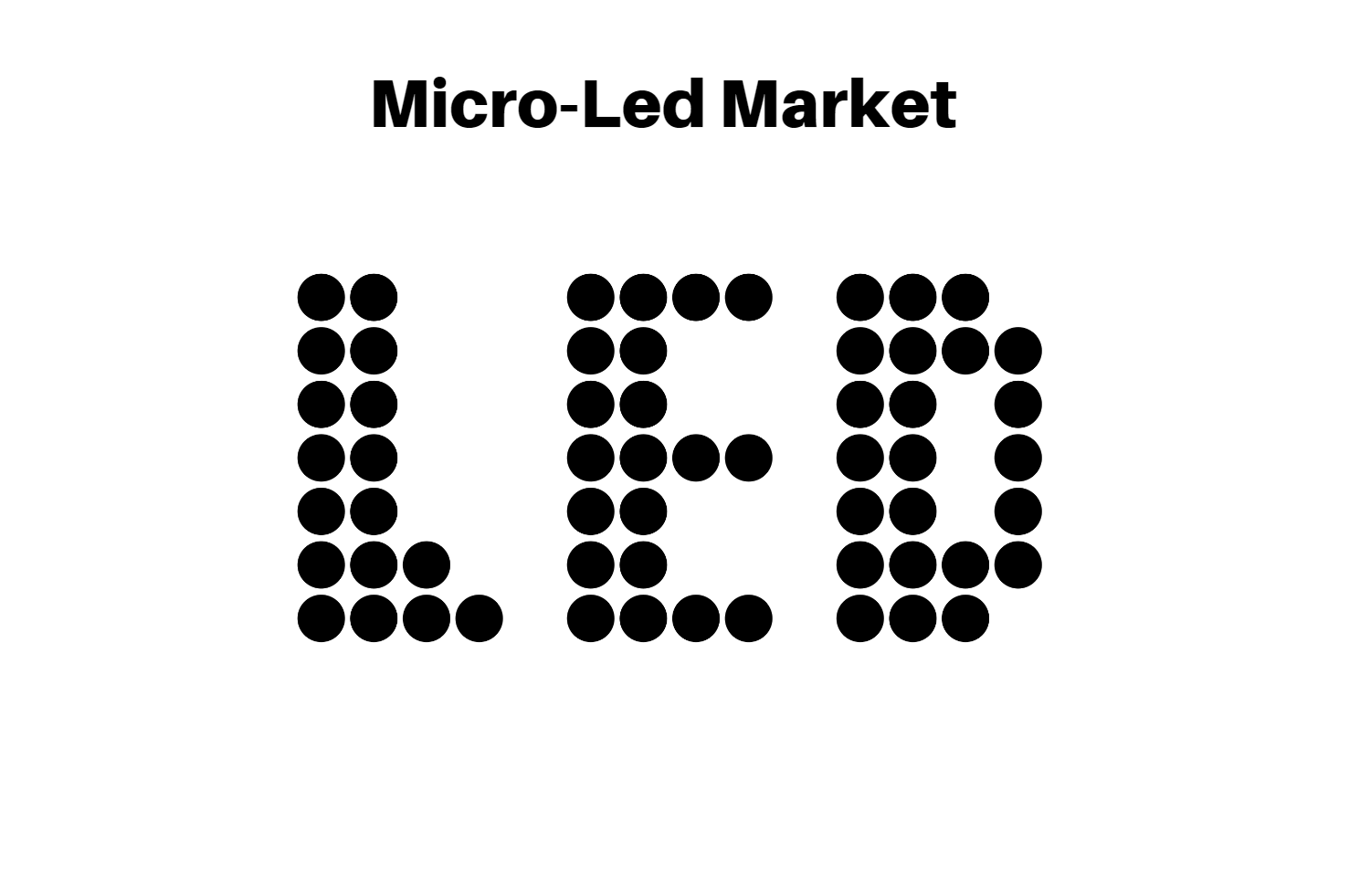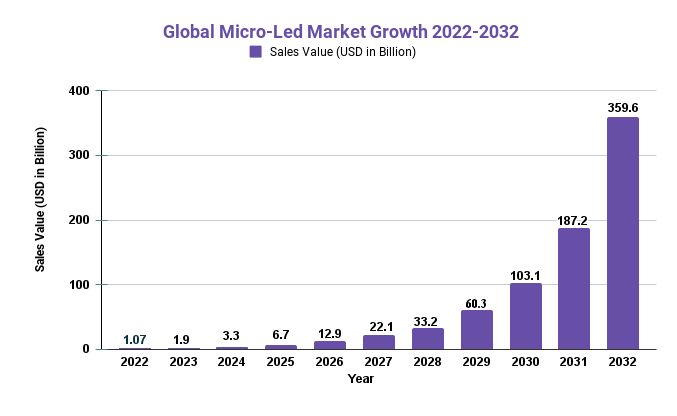Micro-Led Market to Reach USD 359.6 billion by 2032

Page Contents
Market Overview
Published Via 11Press: The Micro-Led Market size is expected to be worth around USD 359.6 Bn by 2032 from USD 1.07 Bn in 2022, growing at a CAGR of 81.5% during the forecast period from 2022 to 2032.
The Micro-LED Market is a rapidly developing industry that has the potential to provide superior display solutions. Micro-LEDs offer superior brightness, contrast, and color accuracy when compared with traditional LEDs. As demand for better visual experiences in various applications such as smartphones, TVs, smartwatches, and other wearable devices grows, so does the micro-LED market.
Recent advances in micro-LED technology have enabled ultra-thin and flexible displays with high pixel densities, providing new possibilities for product design and innovation. Utilizing micro-LEDs promises significant improvements to power consumption, viewing angles, and durability as well as reduced manufacturing costs. As a result, many major companies are investing heavily in research and development efforts to bring this technology to market.
Key Takeaways
- The Micro-Led market expected to reach USD 1.07 Billion in 2022.
- Forecasted compound annual growth rates between 2022 and 2032 is 81.5%.
- By 2032, the Micro-Led market is projected to reach USD 359.6 Billion.
- Growing Demand for Brighter and Energy-Efficient Displays, The micro-LED market is being driven by an increasing need for brighter and energy-saving displays in various applications such as smartphones, smartwatches, AR/VR devices, automotive displays, and TVs.
- Strong competition in the micro-LED market, The micro-LED market is highly competitive, with many companies investing in research and development to improve technology and reduce costs.
- High Cost of Production, Despite the advantages of micro-LED technology, manufacturers face an enormous hurdle, an expensive production process, and the use of expensive materials such as gallium nitride that make it difficult to produce displays at a reasonable cost.
- Micro-LED Market Gaining Popularity in Wearable Devices, The micro-LED market is seeing increasing interest from wearable device makers such as smartwatches and fitness trackers due to its small form factor, low power consumption, and high brightness of displays.
- Potential for Large-Scale Adoption in the Future, While micro-LED technology is still developing, there is potential for broad adoption as manufacturers strive to refine and reduce costs. This could result in the widespread usage of micro-LED displays across various applications such as consumer electronics, automotive displays, or large commercial displays.
Request For Sample Report Here: https://market.us/report/micro-led-market/request-sample/

Regional Analysis
- The Asia-Pacific region is the leading market for micro-LEDs, with China, Japan, and South Korea as major contributors. The high demand for consumer electronics such as smartphones, TVs, and wearables is fueling this growth in this region.
- North America is the second-largest market for micro-LEDs, with the United States leading the pack. Major tech firms such as Apple and Google are propelling growth in this region's micro-LED market.
- Europe is a major market for micro-LEDs, with countries like Germany, France, and the UK dominating sales. The expansion of the automotive industry and an increasing need for high-quality displays are fueling this region's micro-LED growth.
- The rest of the world, including Latin America, the Middle East, and Africa, has seen a meteoric rise in micro-LED demand due to the increased adoption of smartphones, smartwatches, and other consumer electronics in these regions. As a result, micro-LED prices continue to soar.
- Overall, the micro-LED market is expected to expand across all regions as demand for brighter, energy-saving displays continues to rise.
Drivers
High Brightness Micro-LEDs boast higher brightness and color saturation compared to traditional LED displays, making them ideal for high-quality displays in various applications such as smartphones, smartwatches, AR/VR devices, and automotive displays. Energy Efficiency Micro-LEDs are more energy-efficient than traditional displays since they don't need a backlight and can be driven with low voltage. This makes them perfect for portable devices like smartphones, tablets, and smartwatches that require long battery life.
Miniaturization Micro-LEDs are small in size and can be made into ultra-thin and flexible displays, making them perfect for wearable devices and other applications that require small form factors. Durability Micro-LEDs offer greater durability than traditional displays due to their resistance to water, dust, and shock making them perfect for outdoor and rugged applications.
Increasing Demand for High-Quality Displays The demand for high-quality displays is rising across a variety of industries, such as consumer electronics, automotive, and healthcare fueling the growth of the micro-LED market. Technological Advancements Recent technological breakthroughs have made it possible to manufacture micro-LED displays with higher yields and at lower costs, which is fueling the growth of this market.
Overall, high brightness, energy efficiency, miniaturization, durability, and the growing demand for high-quality displays are the primary driving forces in the micro-LED market.
Restraints
High Cost of Production Micro-LED displays requires expensive equipment and materials for production, making them more expensive than traditional LED displays. This high cost may restrict market expansion, particularly in low-end products or price-sensitive markets. Complex Manufacturing Process The manufacturing process for micro-LED displays is intricate and time-consuming, necessitating high precision and quality assurance. This complexity can slow down production rates as well as increase manufacturing costs.
Limited Production Capacity Micro-LED production is still in its early stages and currently has limited capacity, which could make it challenging for manufacturers to meet the demand for micro-LED displays. Integration Challenges Due to their small size and complex structure, integrating micro-LED displays with other components such as drivers, controllers, and power management units can prove challenging.
Limited Access to Standardization The absence of standardization in the manufacturing process can result in inconsistent micro-LED display quality, making it difficult for manufacturers to achieve economies of scale. Alternative Technologies Other technologies such as OLED and QLED offer similar advantages to micro-LEDs at lower costs, which may limit their adoption in certain markets.
Overall, these challenges may hinder the growth of the micro-LED market in the short run however, as technology improves and costs drop and production capacity expand, these obstacles should be overcome and growth to continue apace.
Ensure everything is in line with your specific requirements here: https://market.us/report/micro-led-market/#inquiry
Opportunities
Emerging Applications Micro-LED technology is still in its early stages, and several emerging applications, such as AR/VR devices, automotive displays, and smart home appliances, could benefit from its unique advantages. Advancements in Manufacturing Processes As the manufacturing process for micro-LED displays continues to advance, it is expected that production costs will decrease and capacity will expand, making these displays more accessible and affordable to a wider range of markets.
Collaborations and Partnerships, Collaborations and partnerships among key players in the micro-LED ecosystem, such as manufacturers, suppliers, and research organizations can help expedite technological advancements and bring new products to market faster. Growing Demand for Wearable Devices The rising popularity of wearable devices such as smartwatches and fitness trackers are driving the growth of the micro-LED market, as these items require displays that are small, energy-efficient, and high in quality.
Growing Demand for Large-Screen Displays, The rising popularity of large-screen displays, such as TVs and digital signage, is fueling the growth in the micro-LED market, which offers superior brightness, color saturation, and energy efficiency. Increased Investment, The microLED market is seeing increased investment from governments, private companies, and venture capitalists, encouraging innovation, research, and development of new products and applications.
Overall, the micro-LED market offers several prospects for growth and development, particularly in emerging applications, collaborations, and partnerships as well as increasing demand for wearable devices and large-screen displays.
Challenges
High Manufacturing Cost, Micro-LED displays require complex and costly production, potentially restricting their availability in price-sensitive markets and the number of manufacturers who can manufacture them. Technological Challenges Micro-LED displays present technological challenges due to their small size and intricate structure; integration with other components like drivers, controllers, power management units is difficult due to their technological complexity. Limited Production Capacity Micro-LED production is still at its early stages; currently available capacity is quite limited which may make it difficult for manufacturers to keep up with growing demand for micro-LED displays.
Limited Standardization, The lack of standardization in the manufacturing process can lead to inconsistent micro-LED display quality and make it difficult for businesses to realize economies of scale. Alternative Technologies, Such as OLED or QLED, offer similar advantages at lower costs but may be too expensive in certain markets. Intellectual Property Issues, Micro-LED technology is subject to several patents and intellectual property disputes which could present legal obstacles and limit who enters the market.
Overall, these challenges may impede the growth and adoption of micro-LED technology. However, as this technology continues to progress and improve, it's expected that these issues will be overcome and the micro-LED market will continue to expand into new applications and markets.
Recent Development
- August 2022: Ennostar announced an NTD 3.62 billion investment (USD 122 million) in Epistar to expand its production capacity for MicroLED wafers of 150 mm.
- December 2021: MICLEDI Microdisplays announces the first industry-first microLED arrays for AR built on a 300mm CMOS platform. The 300mm product strategy is a unique manufacturing process that enables MICLEDI to be a preferred display partner for AR glass manufacturers. It also provides unparalleled performance and cost-efficiency.
Report Scope
| Report Attribute | Details |
| The market size value in 2022 | USD 1.07 Bn |
| Revenue forecast by 2032 | USD 359.6 Bn |
| Growth Rate | CAGR Of 81.5% |
| Regions Covered | North America, Europe, Asia Pacific, Latin America, and Middle East & Africa, and the Rest of the World |
| Historical Years | 2017-2022 |
| Base Year | 2022 |
| Estimated Year | 2023 |
| Short-Term Projection Year | 2028 |
| Long-Term Projected Year | 2032 |
Key Market Segments
Type
- The Micro Display
- Small, Medium Sized Panels
- Large Panel
Application
- Consumer Electronics
- Advertising
- Car
- Aerospace Defense
- Other
Key Market Players
- Apple
- Sony
- X-Celeprint
- Samsung Electronics
- OCULUS VR
- Epistar
- Verlase Technologies
- Jbd
- Aledia
Frequently Asked Questions
What is the market study period?
The Micro-Led Market is studied from 2017 – 2032.
What is the growth rate for the Micro-Led Market?
The Micro-Led Market is growing at a CAGR of 81.5%
Which region experiences the highest rate of growth in the Micro-Led Market?
Asia Pacific is growing at the highest CAGR over 2022- 2032.
Which region is the largest in the Micro-Led Market?
North America holds the highest share in 2022.
Who are the major players in the Micro-Led Market?
Apple, Sony, X-Celeprint, Samsung Electronics, OCULUS VR, Epistar, Verlase Technologies, Jbd, Aledia
The team behind market.us, marketresearch.biz, market.biz and more. Our purpose is to keep our customers ahead of the game with regard to the markets. They may fluctuate up or down, but we will help you to stay ahead of the curve in these market fluctuations. Our consistent growth and ability to deliver in-depth analyses and market insight has engaged genuine market players. They have faith in us to offer the data and information they require to make balanced and decisive marketing decisions.



